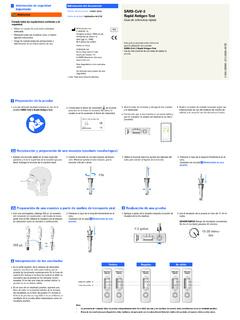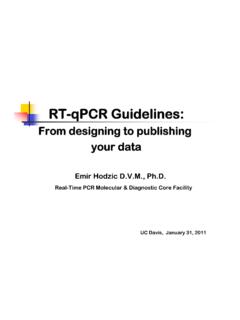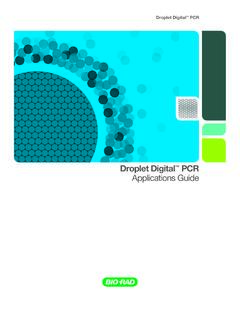Transcription of VENTANA MMR IHC Panel - Roche Diagnostics
1 1016702US Interpretation Guide 2017 1 VENTANA MMR IHC Panel Interpretation Guide for Staining of Colorectal Tissue VENTANA anti-MLH1 (M1) Mouse Monoclonal Primary Antibody VENTANA anti-PMS2 (A16-4) Mouse Monoclonal Primary Antibody VENTANA anti-MSH2 (G219-1129) Mouse Monoclonal Primary Antibody VENTANA anti-MSH6 (SP93) Rabbit Monoclonal Primary Antibody VENTANA anti-BRAF V600E (VE1) Mouse Monoclonal Primary Antibody 1016702US Interpretation Guide 2017 2 Table of Contents Introduction .. 3 VENTANA MMR IHC Panel .. 4 Use of the VENTANA MMR IHC Panel to identify MMR Status and Probable Lynch Syndrome .. 4 VENTANA MMR IHC Panel .. 5 Intended Use of Product .. 5 Purpose of Interpretation Guide .. 5 Clinical Evaluation of MMR IHC Assays .. 7 Evaluating Staining Patterns and Intensities .. 7 Specimen Flow .. 8 Morphology and Background Acceptability Criteria.
2 9 System-Level Control .. 9 Internal Positive Controls .. 11 CRC Case Criteria for Clinical Evaluation .. 12 Scoring Algorithm for MMR IHC Assays .. 13 Decision Tree .. 14 Cases with Intact MMR Status .. 15 CRC Cases with Intact MMR protein expression .. 15 Cases with MMR Status of Loss .. 19 CRC Cases with loss of MMR protein expression .. 19 Challenging Cases .. 23 Non-specific background staining .. 24 Focal Staining .. 26 Punctate Staining .. 27 Clinical Evaluation of VENTANA anti-BRAF V600E IHC Assay .. 28 Evaluating Staining Patterns and Intensities .. 28 Specimen Flow .. 29 Morphology and Background Acceptability Criteria .. 30 System-level Control .. 30 Scoring Algorithm for the VENTANA anti-BRAF V600E Assay .. 31 Decision Tree .. 32 Cases Negative for BRAF V600E .. 33 CRC Cases with BRAF V600E (VE1) Negative Status .. 33 Cases Positive for BRAF V600E .. 35 CRC Cases with BRAF V600E (VE1) Positive Status.
3 35 Challenging Cases .. 39 Non-Specific Background Staining .. 40 Non-Specific High Background Staining .. 41 Nuclear 42 Focal Staining .. 44 VENTANA MMR IHC Panel Case Examples .. 45 Cut Slide Stability .. 49 References .. 50 1016702US Interpretation Guide 2017 3 Introduction Colorectal Cancer and Lynch Syndrome Colorectal cancer (CRC) is the third most common cancer in men, and the second in women, with an estimated million new cases and 694,000 deaths occurring worldwide in 2012. Incidence rates vary widely by geographic location, with the highest estimated rates in Australia/New Zealand, Europe, and North In the United States alone CRC represents of all new cancer cases and an estimated million people were living with colon and rectum cancer as of The risk of developing CRC is influenced by both environmental factors ( , dietary factors, obesity, smoking and alcohol use) and genetic factors.
4 While the majority of CRC cases are sporadic in nature, 5-10% of cases are due to inherited autosomal dominant The most common subtype of hereditary CRC is Lynch syndrome, which accounts for 3% of all CRC Lynch syndrome (Hereditary Non-Polyposis Colon Cancer, HNPCC), was described in the 1960s and identified a link between the loss of DNA mismatch repair (MMR) function and Loss of any MMR protein (MLH1, PMS2, MSH2 or MSH6) may lead to microsatellite instability and a higher risk of not only colorectal cancer, but also cancer of stomach, brain, skin and, in women, endometrium and ovaries. Patients with Lynch syndrome have a 40-60% lifetime risk for colorectal Stratification for Lynch Syndrome in CRC Using IHC assays for MLH1, PMS2, MSH2, and MSH6, the MMR status of the tumor may be determined. Detection of all four proteins in the tumor indicates normal or proficient mismatch repair status (pMMR).
5 Loss of MLH1 expression is almost invariably accompanied with the loss of its heterodimer partner, PMS2. In sporadic occurrences of CRC, expression of the MLH1 gene may be suppressed by methylation of its promoter. If the result indicates a loss of MLH1 protein, testing to see if the BRAF V600E mutation is present will stratify the tumor as sporadic or possible Lynch syndrome and indicate the need for additional testing of the MLH1 promoter methylation state. The presence of the BRAF V600E mutation with loss of MLH1 protein indicates the tumor is the result of a sporadic occurrence and makes Lynch syndrome as the underlying cause of malignancy highly If BRAF V600E mutation and MLH1 promoter methylation is negative, the deficient DNA mismatch repair (dMMR) status is consistent with Lynch syndrome and warrants genetic testing for a confirmatory The use of IHC for the detection of PMS2, MSH2 and MSH6 proteins is a more direct indicator of germline mutational status.
6 The loss of PMS2, in the presence of MLH1 expression, or loss of MSH2 or MSH6 expression designates the 1016702US Interpretation Guide 2017 4 tumor as dMMR and is consistent with Lynch syndrome. All individuals with suspected Lynch syndrome would be referred for genetic counseling and further genetic testing to confirm the presence of the suspected mutation. VENTANA MMR IHC Panel Use of the VENTANA MMR IHC Panel to identify MMR Status and Probable Lynch Syndrome The VENTANA MMR IHC Panel ( VENTANA anti-MLH1 (M1) Mouse Monoclonal Primary Antibody, VENTANA anti-PMS2 (A16-4) Mouse Monoclonal Primary Antibody, VENTANA anti-MSH2 (G219-1129) Mouse Monoclonal Primary Antibody, VENTANA anti-MSH6 (SP93) Rabbit Monoclonal Primary Antibody and VENTANA anti-BRAF V600E (VE1) Mouse Monoclonal Primary Antibody) aids in the identification of patients with a deficiency in MMR and the stratification of colorectal cancer (CRC) as sporadic or probable Lynch syndrome.
7 This is summarized in Figure 1. Figure 1: Use of VENTANA MMR IHC Panel 1016702US Interpretation Guide 2017 5 VENTANA MMR IHC Panel Intended Use of Product The VENTANA MMR IHC Panel is a qualitative immunohistochemistry (IHC) test intended for use in the light microscopic assessment of mismatch repair (MMR) proteins (MLH1, PMS2, MSH2, and MSH6) and BRAF V600E proteins in formalin- fixed , paraffin - embedded colorectal cancer (CRC) tissue sections. The OptiView DAB IHC Detection Kit is used with MLH1, MSH2, MSH6 and BRAF V600E, and the OptiView DAB IHC Detection Kit with OptiView Amplification Kit is used for PMS2 detection. The VENTANA MMR IHC Panel is for use on the VENTANA BenchMark ULTRA instrument. The VENTANA MMR IHC Panel includes VENTANA anti-MLH1 (M1) Mouse Monoclonal Primary Antibody, VENTANA anti-PMS2 (A16-4) Mouse Monoclonal Primary Antibody, VENTANA anti-MSH2 (G219-1129) Mouse Monoclonal Primary Antibody, VENTANA anti-MSH6 (SP93) Rabbit Monoclonal Primary Antibody, and VENTANA anti-BRAF V600E (VE1) Mouse Monoclonal Primary Antibody.
8 The VENTANA MMR IHC Panel is indicated in patients diagnosed with colorectal cancer (CRC) to detect mismatch repair (MMR) proteins deficiency as an aid in the identification of probable Lynch syndrome and to detect BRAF V600E protein as an aid to differentiate between sporadic CRC and probable Lynch syndrome. Results from the VENTANA MMR IHC Panel should be interpreted by a qualified pathologist in conjunction with histological examination, relevant clinical information, and proper controls. The clinical performance of this device to guide treatment of MMR deficient patients has not been established. Intended for in vitro diagnostic (IVD) use. Prescription Use Only. Purpose of Interpretation Guide This guide is intended to aid pathologists in the clinical evaluation of formalin- fixed , paraffin - embedded ( ffpe ) colorectal carcinoma sections stained with the assays that comprise the VENTANA MMR IHC Panel in accordance with the proposed product labeling.
9 Specifically this guide: Provides photographic images that illustrate the patterns and intensities of staining that may result from staining of colorectal carcinoma tissues with the assays that comprise the VENTANA MMR IHC Panel . Provides a reference for relating staining patterns and intensities to specific MMR biomarker clinical scores. Provides examples of challenging cases. Discusses other controls that may be used with the assay but are not provided by VENTANA 1016702US Interpretation Guide 2017 6 Specimen Flow for Staining with the VENTANA MMR IHC Panel Tissue sample of colorectal carcinoma is taken from the patient, fixed in 10% neutral buffered formalin for 6-48 hours according to standard lab practices and embedded in 4-5 microns in thickness are mounted on positively charged section is stained with H& the H&E slide acceptable? ( 50 viable tumor cells)NORepeat StainingYESFor each assay in the VENTANA MMR IHC Panel :(1) One section is stained with a one of the following: VENTANA anti-MLH1(M1) VENTANA anti-PMS2(A16-4) VENTANA anti MSH2 (G219-1129) VENTANA anti-MSH6 (SP93) VENTANA anti-BRAF V600E (VE1)(2) One section is stained with a negative reagent control antibody (corresponding to the species of the respective VENTANA MMR IHC Panel assay) in the same staining run.
10 1016702US Interpretation Guide 2017 7 Clinical Evaluation of MMR IHC Assays Evaluating Staining Patterns and Intensities Cells labeled with the IHC assays for the four MMR proteins (MLH1, PMS2, MSH2 and MSH6) are evaluated for presence or loss of the diaminobenzidine (DAB) signals. In colorectal carcinoma, the immunohistochemical staining of the four MMR proteins follows a nuclear staining pattern. In CRC cases with Lynch syndrome or somatic mutations, loss of any one of the four MMR proteins detected by the MMR IHC Assays is observed in the nuclei of tumor cells. The signal is classified as Intact or Loss based on nuclear localization only. Positive (Intact) signal is characterized by tumor cells that exhibit unequivocal nuclear staining of any intensity above background. Negative (Loss) signal intensity is characterized by an absence of any detectable signal or pale grey or tan nuclear discoloration in tumor cells.
















